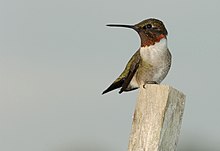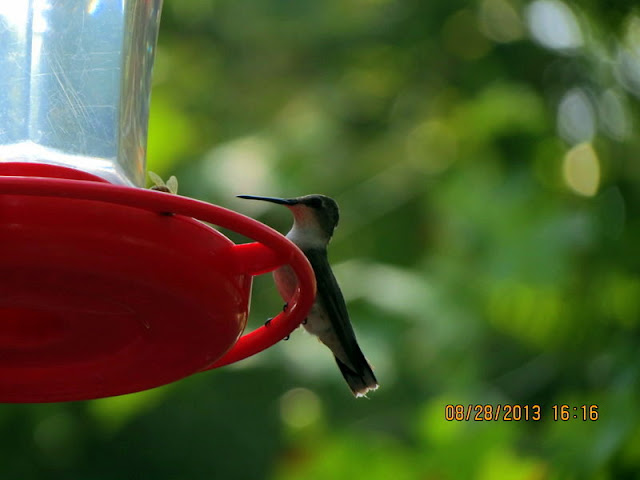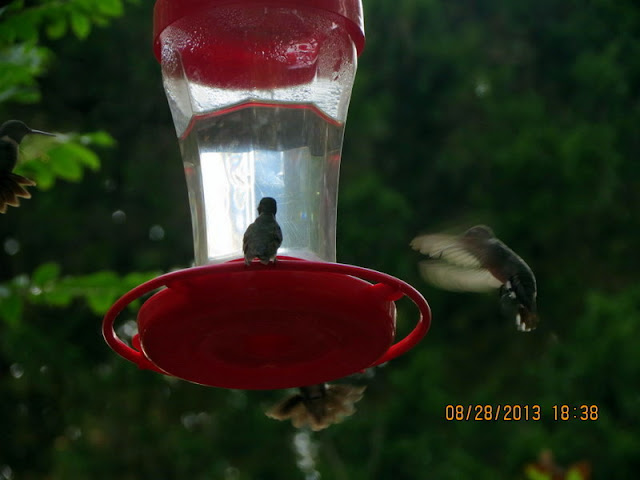Hum, Hum, Hum, Here they come! It is totally awesome to watch the girls and juvenile birds come humming in! Elvis and the boys are zipping through the air with heightened excitement. Today Elisabeth returned. Now, I only know 3 out of hunderds of these tiny birds: Elvis, Elisabeth and Snowball. These birds have been coming for 5 years and I have their photos. These I know by their behavior, as in showing off for the camera and buzzing me. I do not know how they know that I share the photos with the world. They said a little birdie told them so! Your photostudy tonight is of the little show offs at feeder #1 (Kates Back Porch). I am always amazed that they travel so far and still make it back every year! Enjoy!
(Elisabeth)
https://en.wikipedia.org/wiki/Ruby-throated_Hummingbird
Ruby-throated Hummingbird
From Wikipedia, the free encyclopedia
| Ruby-Throated Hummingbird | |
|---|---|
 | |
| Conservation status | |
| Scientific classification | |
| Kingdom: | Animalia |
| Phylum: | Chordata |
| Class: | Aves |
| Order: | Apodiformes[2] |
| Family: | Trochilidae |
| Genus: | Archilochus |
| Species: | A. colubris |
| Binomial name | |
| Archilochus colubris (Linnaeus, 1758) | |
 | |
| Green: summer-only range Blue: winter-only range Yellow: migratory path | |
| Synonyms | |
Trochilus colubris
| |
The Ruby-throated Hummingbird (Archilochus colubris) is a species ofhummingbird. As with all hummingbirds, this species belongs to the Trochilidaefamily and is currently included in the Apodiformes order. This small animal is the only species of hummingbird that regularly nests east of the Mississippi River inNorth America.
Diet
Nectar from flowers and flowering trees, as well as small insects and spiders, are its main food. Although hummingbirds are well known to feed on nectar, smallarthropods are also an important part of adult hummingbirds' diet. Arthropods appear to be the main source of protein, minerals, vitamins, providing a protein source. Their diet may also occasionally include tree sap taken from sapsucker wells. Hummingbirds show a slight preference for red, tubularflowers as a nectar source. The birds feed from flowers using a long extendendable tongue, and catch insects on the wing or glean them from flowers, leaves, bark, and even from spider's webs.
Young birds are fed insects for protein since nectar is an insufficient source of protein for the growing birds.[9]
Reproduction
Ruby-throated hummingbirds are thought to be polygynous. Polyandry andpolygynandry may also occur. They do not form breeding pairs, with males departing immediately after the reproductive act and females provide all parental care.[10]
Males arrive at the breeding area in the spring, and establish a territory before the females arrive. When the females return, males court females that enter their territory by performing courtship displays. They perform a “dive display” rising 8 – 10 feet above and 5 – 6 feet to each side of the female. If the female perches, the male begins flying in very rapid horizontal arcs less than 0.5 m in front of her.
If the female is receptive to the male, she may give a call and assume a solicitous posture with her tail feathers cocked and her wings drooped.
The nest is usually constructed on a small, downward-sloping tree limb 3.1 to 12.2 m (10 to 40 ft) feet above the ground. Favored trees are usually deciduous, such as oak,hornbeam, birch, poplar or hackberry, although pines have also been used. Nests have even been found on loops of chain, wire, and extension cords.[5] The nest is composed of bud scales, with lichen on the exterior, bound with spider's silk, and lined with plant down (often dandelion or thistle down). Most nests are well camouflaged. Old nests may be occupied for several seasons, but are repaired annually[citation needed]. The female constructs the nest, as the male has left by this point.
Females lay two (with a range of 1 to 3) white eggs about 12.9 mm × 8.5 mm (0.51 in × 0.33 in) in size, and produce one to two broods each summer.[5] They brood the chicks over a period of 12 to 14 days. The female feeds the chicks from 1 to 3 times every hour by regurgitation, usually while the female continues hovering. When they are 22 to 25 days old, the young leave the nest and make their first flight.
Longevity and mortality
The oldest known Ruby-throated Hummingbird to be banded was 9 years and 1 month of age. Almost all hummingbirds of 7 years or more in age are females, with males rarely surviving past 5 years of age. Reasons for higher mortality in males may include loss of weight during the breeding season due to the high energetic demands of defending a territory followed by energetically costly migration. There are several small animals who prey on these hummingbirds given the opportunity. Due to their small size, they are vulnerable even to birds and other animals which generally feed on insects. Chief among their predators are Sharp-shinned Hawks, domestic cats and loggerhead shrikes, all of which are likely to ambush the hummingbird while it sits on a perch. Bird-eating lizards and snakes may also prey on the species, especially on its subtropical wintering grounds. Also largemouth bass,bullfrogs and green frogs have reportedly grabbed hummingbirds when they've attempted to go for a drink, despite their swift flying speeds. Even large, predaceous invertebrates have preyed on Ruby-throated Hummingbirds, including praying mantises, orb-weaving spiders and Green Darners. Blue jays are common predators of nests.[11][12][13]
Goodnight!
...this is brendasue signing off from Rainbow Creek. See You next time! I am closing with Elisabeth and her rainbow wings! Big Hugs to Everybody!!!
O+O
































































































No comments:
Post a Comment
Hi Everybody! Please say hello and follow so I know you are here! Due to the inconsideration of people trying to put commercials on my blog comment area, I have restricted use of anonymous posts. Sorry that some hurt all.
My public email is katescabin@gmail.com No spammers or trolls